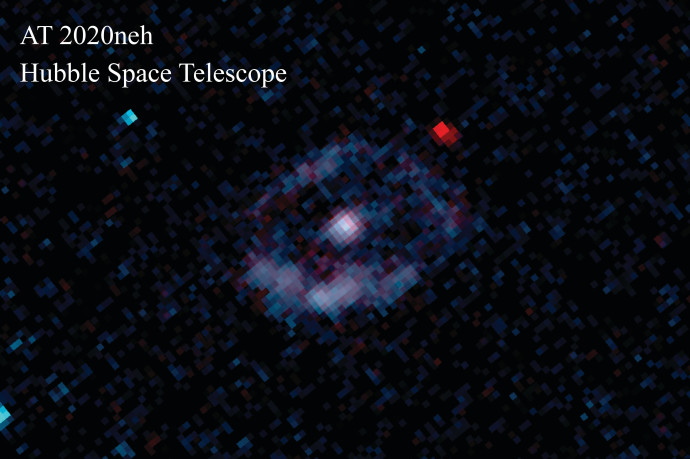A medium-mass black hole lurking undetected in a dwarf galaxy was found by astronomers after it shredded apart an unlucky star that strayed too close to the cosmic entity, letting out a powerful flare.
The galactic outburst was captured by astronomers with the Young Supernova Experiment (YSE), a survey designed to detect cosmic explosions and transient astrophysical events.
An international team led by scientists at UC Santa Cruz, the Niels Bohr Institute at the University of Copenhagen, and Washington State University reported the discovery in a peer-reviewed paper published in Nature Astronomy.
“This flare was incredibly fast, but because our YSE data gave us so much early information about the event, we were really able to pin down the mass of the black hole using it,” First author Charlotte Angus said.
The shredding of the star, known as a “tidal disruption event” or TDE, produced a flare of radiation that briefly outshone the combined stellar light of the host dwarf galaxy and could help scientists better understand the relationships between galaxies and black holes.

“This discovery has created widespread excitement because we can use tidal disruption events not only to find more medium-mass black holes in quiet dwarf galaxies, but also to measure their masses,” said coauthor Ryan Foley, an assistant professor of astronomy and astrophysics at UC Santa Cruz who helped plan the YSE survey.
“This discovery has created widespread excitement because we can use tidal disruption events not only to find more medium-mass black holes in quiet dwarf galaxies, but also to measure their masses.”
Ryan Foley
Dwarf galaxies are thought to harbor black holes with proportionally small masses, including medium-mass ones, like in this case.
Identification of these systems has historically relied on the detection of light emitted from accreting gaseous disks close to the black holes. Without this light, they are difficult to detect.
Data from the Young Supernova Experiment enabled the team to detect the first signs of light as the black hole began to eat the star. Capturing this initial moment was pivotal to unlocking how big the black hole was, because the duration of these events can be used to measure the mass of the central black hole.
This method, which until now had only been shown to work well for supermassive black holes, was first proposed by Ramirez-Ruiz and coauthor Brenna Mockler at UC Santa Cruz.
“The fact that we were able to capture this midsize black hole whilst it devoured a star offered us a remarkable opportunity to detect what otherwise would have been hidden from us,” Angus said. “What is more, we can use the properties of the flare itself to better understand this elusive group of middle-weight black holes, which could account for the majority of black holes in the centers of galaxies.”
Supermassive black holes
Supermassive black holes are found at the centers of all massive galaxies, including our own Milky Way. Astronomers conjecture that these massive cosmic entities, with millions or billions of times the mass of the sun, could have grown from smaller “medium-mass” black holes with thousands to hundreds of thousands of solar masses.
“If we can understand the population of medium-mass black holes out there—how many there are and where they are located—we can help determine if our theories of supermassive black hole formation are correct,” said coauthor Enrico Ramirez-Ruiz, professor of astronomy and astrophysics at UCSC and Niels Bohr Professor at the University of Copenhagen.
One possible explanation for how massive black holes were created in the first place, is that the early universe was rampant with small dwarf galaxies with medium-mass black holes.
Over time, these dwarf galaxies would have merged or been consumed by more massive galaxies, their cores combining each time to build up the mass in the center of the growing galaxy. This repeated merging of start would eventually create the supermassive black holes seen today.
“One of the biggest open questions in astronomy is currently how supermassive black holes form,” said coauthor Vivienne Baldassare, professor of physics and astronomy at Washington State University.
